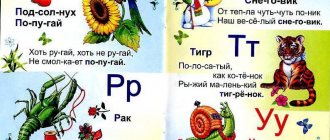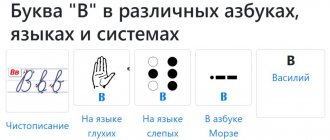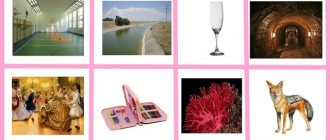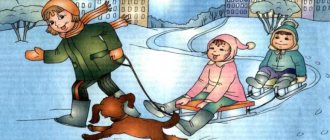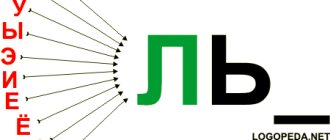Two versions of mnemonic track texts:
- The first option is signed for the convenience of adults. Tex goes immediately below the picture path. It is designed for individual work with children who cannot read.
- The second version of text mnemonic tracks contains only chains of connected pictures. The pictures are larger in size. There is no signed text in the second version so as not to distract reading children. With the second option, you can work both individually and with a subgroup of children. In this case, the text of the story must be printed separately or on the reverse side.
Print the presented pictures on A4 sheets. It is advisable to laminate them, then they will serve you much longer and enjoy doing them.
Or study online on the website.
Types of incorrect articulation of the sound “Z”
When the pronunciation of whistling sounds is distorted, it is called sigmatism; when it is replaced by other sounds, it is called parasigmatism.
There are several types of sigmatism:
- Labial-dental. With this defect, the lower lip stretches upward and the result is “B” instead of “Z” (“task” - “vada”).
- Side. The tongue on the sides, or only on one side, does not rest on the upper teeth, and the air disperses in the mouth, losing pressure and forming a squelching sound “HL” (“sunset” - “slurp”).
- Interdental. The tongue rests between the rows of teeth, creating a lisping sound.
- Nasal. The soft palate descends to the root of the tongue, exhaled air exits through the nose. This produces a nasal "X".
- Prizubny. The tongue rests on the half-closed teeth and does not allow the passing air to move freely, as a result you hear something between “D” and “Z” (“winter” - “dzima”).
- Hissing. The tip of the tongue moves towards the frenulum, it bends towards the upper palate, the lips are rounded and a hiss is obtained instead of a whistle (“lock” - “zhamok”).
What to do if a child does not speak the sound Z and Zь
Option 1. If the child does not say all the whistling sounds (С, Сь, З, Зь, Ц
), then first we work with the sound C and its soft version Сь. And only after that + we call out the sound Z and reinforce its correct pronunciation. If a child has mastered the sound C well, and the sounds C and Сь are perfectly automated in words, phrases, poems, and dialogues, then producing the sound Z will not cause difficulties.
Option 2.
If a child speaks the sounds S and S very well, but pronounces the sound Z incorrectly , then usually there are no problems with pronouncing the sound Z and consolidating its correct pronunciation.
The baby quickly begins to pronounce this sound correctly simply by imitation. So, we begin to work on the sound Z when the child already speaks the sounds S and Сь perfectly. Children are usually ready for this at the age of four.
Important rules:
- State the title of the poem, if available.
- Look at the picture for the poem, discuss with your child who or what is drawn there.
- Read the poem in full: expressively and slowly. If an adult recites it by heart, children perceive such text better. This is a note.
- Explain words you don't understand to your child.
- Say ALL words with the sound “Z” . Remind your child that the sound “Z” must be pronounced correctly.
- Read the poem again.
- An important condition is that the poem is memorized in its entirety , without dividing into rows and columns.
- Play: read the beginning of the line, and the child finishes the rhyme; you are the first line, and the child is the second, etc.
It is better to memorize verses to automate the sound “Z” using visuals in a playful way and using visuals.
Preparatory stage
At the preparatory stage, the correct sound and articulation of the formed “Z” is demonstrated. Articulation and breathing exercises are performed to prepare the child to perform basic positioning exercises.
Stories and fairy tales with the sound Z for classes on ZKR with preschool children.
Bunnies (Lithuanian fairy tale)
Bunnies were born to a hare. The father looked at his children and said to them: “I have a mustache, and you already have a mustache!” So, that means, get your own food. Since then, the little hares, as soon as they are born, live alone, without parents, in a dark forest: they have neither a nest nor a hole. But everyone with a mustache, everyone from the first days can get their own food.
Boy and goats.
Once upon a time there was a boy, and he had three goats. During the day the goats galloped and jumped on the rocks, and by night the boy drove them home. One evening the boy began to drive them home, and the goats ran into the cabbage field, and there was no way to get them out of there. The boy sat down on a hillock and began to cry. A hare walked past. - Why are you crying? – the hare asked the boy. “I’m crying because I can’t drive the goats out of the field,” the boy answered. “I’ll drive them out,” said the hare. The hare began to drive out, but the goats did not come. The hare sat down and also cried. A fox walked past. - Why are you crying? – the fox asked the hare. “I’m crying because the boy is crying,” says the hare, “And the boy is crying because he can’t drive the goats out of the field.” “Calm down, I’ll drive them out,” said the fox. She began to drive out, but the goats would not come. The fox sat down here and also began to cry. And so the wolf drove him away, but he didn’t drive him out either. A bee was flying here. He sees that they are all sitting and crying, and says: “I’ll kick them out.” Then all the animals and the boy stopped crying and began to laugh at the bee. How will she drive out the goats when they all couldn’t cope! But the bee flew to the cabbage field, sat on the goat, and began to buzz. - Zhzhzhzhzh! Zhzhzhzhzh! Zhzhzhzh! How the goats will start running! And they ran home from the field.
Monkey Ruza. The author of the story is A.I. Maksakov. From the book “Development of correct speech of a child in the family” (Publishing house Mozaika - Synthesis, 2011).
“Dad brought Zoya a monkey from Africa. Zoya named the monkey Ruza. Ruza knew how to jump funny and imitate Zoya's friends. Zoya taught Ruza to answer the doorbell. In winter, Ruza fell ill. Zoya took Ruza to the doctor, gave her various herbs, and fed her bananas. Thanks to Zoya’s care, Ruza recovered.”
Ask your child questions about the content of the story. Ask them to find words with the sound Z in the story and make up their own sentences with them.
The story "Girlfriends". Author – M.F. Fomicheva. From the book “Educating Children to Pronounce Correctly.”
“Zoya, Lisa and Aza are friends. Friends gathered at Zoya's. Zoya, Lisa and Aza play together. The Muse doll is put to bed. They go for a walk with a funny bunny. Mom called Lisa home. Azu was also called. Zoya was left alone. Zoya's teeth hurt. Zoya tied her teeth and sits. Lisa found out about this. Zoe brought a mosaic. Aza also found out. I brought Zoya some forget-me-nots. Zoya put forget-me-nots in a vase. Lisa, Zoya and Aza began to play mosaic. They made a beautiful mosaic pattern! Then they asked riddles:
As soon as she got down to business, she sawed and sang. She ate, ate oak, oak, broke a tooth, a tooth. (Saw)
Kuzma is knotty and cannot be untied. ( Chain)
He himself doesn’t know the days, but he points them out to others. (Calendar)
The friends had fun for a long time. Zoya forgot about her bad teeth.”
Ask your child questions about the content of the story. Make sure that he pronounces the sound Z correctly in his answers.
An outdoor game to reinforce the correct pronunciation of the sound Z “Find out by voice.”
Authors: E.I. Radina, V.I. Rozhdestvenskaya.
This game develops children's auditory attention. A circle is drawn on the ground. Children run around the playground. At the adult’s signal, “One, two, three – run in a circle!” they gather in a circle.
The driver is selected. He is blindfolded. He turns his back to the children.
All the children say:
“We frolicked a little, everyone settled down in their places. Guess the riddle, Find out who called you!”
The adult gestures to one of the children, who says: “I’m calling you!” The child driver guesses who called him: “Vova called me? Katya called me?”
If the child guessed who called him, then he changes places with this child. And the other child becomes the driver.
If the child did not guess who called him, then he guesses again in the next game.
In the game you can change your voice, speak in a squeaky high voice or a thick bass voice. It's always interesting and unexpected in this game how players will change their voice.
How to evoke the sound Z by imitation?
In the absence of the sounds З and Зь or their replacement with other sounds, you can first try to evoke the sound З by imitation.
Ask your child to sing the mosquito song zzzzzz.
- Show what position the lips have (smile), tongue (wide with a groove in the middle).
- Pronounce the sound Z – “mosquito song” – slowly.
- Ask your child to repeat it.
Play mosquitoes with your child - reinforce the sound “z”. Remind your child how in the summer mosquitoes in the forest sing their song: “zzzz” and bother us. Let the child be a mosquito in the forest and sing the mosquito song “zzz”, and you will run away from him into the house and hide.
When playing with a group of children, one half of the children “walks in the forest”, the other pretends to be mosquitoes and rings “zzz”. Then the children change roles.
After the children ring like mosquitoes, show them the difference in the articulation of the sound C and the sound Z. Sit in front of the mirror. And compare the sounds s (“pump song”) and the sound z (“mosquito song”). Draw the children’s attention to the fact that the sound C—“pump song”—sounds quietly, and the mosquito song sounds loud—zzzz—and a voice can be heard. The mouth is the home of the voice. And when the voice loudly sings the song of a mosquito, even the walls of the house tremble. And you can feel it.
Demonstrate these unusual sensations to your child. First, place the child’s hand on your neck when you say the sound Z. Let him feel the vibration as you pronounce the sound “z.” Then ask your child to put one hand on the back of your neck, and the other hand on his neck, and sing the mosquito song “zzzzz” with him. Children usually really like this task, new sensations that are unexpected for them.
Compare with the sound C - “pump song”. Pull the ssss sound. Trembling - no vibration! Tell your child that the sound C is a dull, quiet sound, our voice sleeps. And the sound Z is loud, ringing, the voice loudly sings the song zzzzz.
Very often this exercise and explanation is enough for the sound Z to appear in the child’s speech.
What difficulties may arise when working with the sounds З and Зь? Useful tips.
Advice one. If a child cannot make the sound Z, then the reason may be insufficient development of the organs of the articulatory apparatus.
Articulation exercises for whistling sounds will help cope with this problem. You will find a detailed complex of articulation gymnastics in step-by-step descriptions and videos in the article “How to teach a child to pronounce the sounds C and Сь.”
Tip two. If a child cannot make a groove in the middle of his tongue when pronouncing the sound Z, then most likely his tongue muscles are underdeveloped. Exercises will help us:
- Ask your child to smile widely (stretch their lips) and hold their lips in this position. If your lips are stretched, you need to stick your outstretched tongue out and blow on its tip. You will get a groove in the middle of the tongue. The exercise is carried out in front of a mirror.
- If the groove does not work, then ask the child to stick the wide tip of his tongue out. Place the edge of a teaspoon in the middle of your tongue. Having made a small depression in it, ask the child to blow air along this groove. You can blow on cotton wool or a thin strip of paper, then the result of the exercise will be clearly visible. As soon as the child can easily do this exercise, you can ask him to move his tongue behind his lower teeth (maintaining the position of his lips). The result is the sound S. When you add a voice to it, you get the sound Z.
- The exercise described above can be done with a glass vial (a glass jar or bottle from a pharmacy). Teach your child to whistle into a bubble so that the tip of the tongue moves slightly outward or touches the edges of the bubble. Air flows along the groove in the middle of the tongue and the result is a whistle. First, try whistling yourself in front of a mirror, and then show the exercise to your child. If the groove in the middle of the tongue does not work out for him, place a thin round stick along the tongue.
Tip three. If a child sticks his tongue out between his lips when pronouncing the sound Z
(therefore the sound is distorted), then do this exercise. Ask your child to stretch his lips into a smile and close his teeth tightly. And whistle like a pump ssssss. And then sing like a mosquito zzzzzzz. With clenched teeth, the tongue will automatically rest against the lower teeth, and the correct sound will be produced.
You will learn more about the methods of producing sounds S and Z from a video by a speech therapist about producing whistling sounds.
The sound Z appeared. Now we are faced with an important task - to automate this sound in the child’s speech.
The sequence of exercises to consolidate the correct pronunciation of the sound Z:
- 1. exercises with isolated sound,
- 2. sound in syllables,
- 3. sound in words
- 4. sound in phrases, poems, stories, dialogues, tongue twisters.
First we work with the sound Z, and then with its soft version - the sound Зь. Games, tongue twisters, nursery rhymes, poems, and pictures are selected for each stage.
